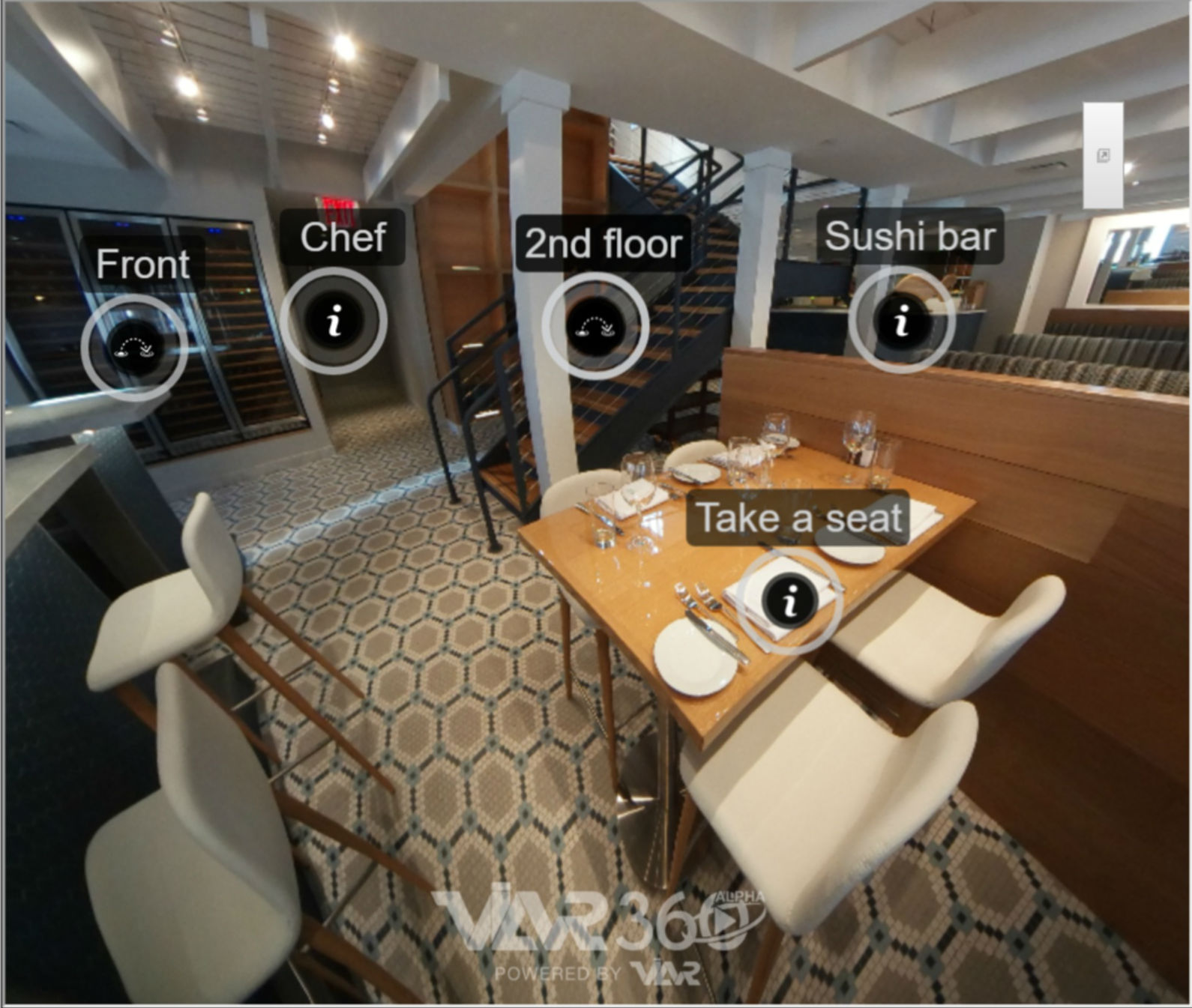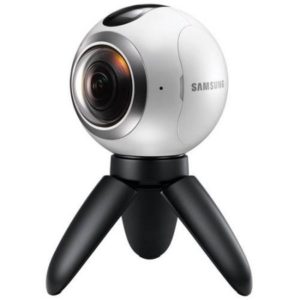
23 Dec Using 360 photos to amplify a restaurant profile
For my Emerging Media Platforms class at Syracuse, I was tasked with developing a field test using one of the technologies we had discussed in class and testing a hypothesis based on that field test. Below is the summary of my full report and results, along with a working model. Here’s the full report.
Field Test Hypothesis
As media companies from the New York Times with its Daily 360 videos to USA Today with its recent ride in a Blue Angels plane, the use of 360 photos and video is become more commonplace or visually stunning stories. I sought to test whether the technology — combined with the annotation program Viar360 — could also enhance the storytelling experience of a restaurant profile, or if readers accustomed to straight text would find them an annoyance.
The idea was to not only wow people with an immersive photographic experience that would give them a sense of what the restaurant looked like from different vantage points in a way that hadn’t been done before, but also provide details that added value to the story. That could include bits of information, photos, or even audio and video (I did not includ e the latter two).
e the latter two).
The Technology
360 cameras are increasingly being used by media companies for various stories, and their usage will only grow as they become more ubiquitous, cheaper and easier to use. I chose the Samsung Gear 360 because it was highly rated on numerous camera bulletin boards and shopping sites, and it is what that New York Times is using for its Daily 360 project. The camera is equipped with two 180-degree, 30-megapixel lenses and is splash- and dust-resistant. You may opt to use only one lens, either the front or rear, or both at the same time for the full 360-degree experience.
The Field Test
I had considered several scenic restaurants with good lighting for the setting of my field test, but chose to go with a new H20 Seafood & Sushi-East Islip, which I had learned would be opening in the coming days. This would not only be a good opportunity to write about the restaurant’s opening, but I liked the sneak-peek factor to attract readers.
At H20 Seafood & Sushi on Dec. 10, I started by taking some regular photos with my DSLR of the restaurant, which was still in final stages of renovation, but plenty good to shoot. I then used the Gear 360 and took photos in several locations.
In the Viar360 editor, I used the photo of the restaurant’s center as my starting point to get to other places in the presentation. I added annotations and photos about the bar, the chef and the new sushi bar, and created transitions to the other two locations. Each photo needed transitions to get back to the starting point.
Here’s the final product and the story (continued below):
Metrics
In the four days since the story went live, it’s gotten 292 Facebook shares via Long Island Pulse’s website and dozens more likes on the H20 Facebook page,
According to Viar360’s analytics, the presentation garnered 2,150 views and 1,337 unique visitors as of 10:50 a.m. Dec. 23. Considering this is a pre-holiday week, that is pretty impressive.
Feedback
A majority of people who responded to an online survey (9 out 16, or 56.25 percent) said it was “a great experience” and that “all restaurant profiles should include them.” The remaining people surveyed said:
- It was OK, but I was more interested in the story. (4)
- It was a distraction. (2)
- It didn’t work at all on my device. (1)
Six people provided comments, both positive and negative, via Survey Monkey:
- “There are some hiccups, but it really gave a feel for the environment.”
- “waste of time.”
- “The stitching was very obvious, which was a distraction. I would have liked the option to make the 360 image full screen. I liked the info points.” [Note: There is an option to go full-screen, would also allow someone to use Samsung’s virtual reality goggles if they had them, but it apparently did not work for some.]
- “it didn’t work on my browser.”
- “I did stop reading after I got to the VR tour so that I could play with the video — so placement in a story may make a difference. But I still stayed on the story and probably for a lot longer as a result. So I’m not sure I would change the placement of it either. :)”
- “This looks great and it worked well on my phone.”
The vast majority of respondents also rated the inattentiveness and quality of the experience positively.
Conclusion
Based the feedback, engagement and my personal impressions of whether this was a good value-add to the storytelling experience of a restaurant profile, the answer is yes, with the caveat that there is a lot of room for improvement. I feel I accomplished what I hoped to achieve in this field test, despite technical snags. Readers were given an inside look at restaurant in a new way even before it opened and the vast majority, according to my survey, enjoyed it.
Areas for improvement
- The No. 1 thing that needs to be fixed, if someone plans to use a Samsung Gear 360, is that it must become iOS compatible. By only being compatible with the most advanced Galaxy devices, the company is limited its reach, including among journalists. The Galaxy-only approach will also only lead hackers to develop a workaround. Samsung may, in fact, come out with an iOS app to come alongside the launch of its future so-called “Gear 360 Pro.”
- There should be an option to change the point of view of a photo after it is stitched using the app or potentially even a small screen that could be part of the Gear 360 itself.
- In Viar360, I found a number of bugs. One was being able to move the annotation icons as even when I was out of editing mode.
- Users should also be able to click out of annotated areas with an “X” at the top of the box.
- Embed code should be clear-cut. It should not have to be adjusted to fit particular websites.
- Although the quality of the photos was high, the areas where the two lenses of the Gear 360 stitched was quite evident. I’m not sure if that was user error on my part or a matter of the the program, but the I don’t want to see the stitched areas. I want it to feel as real as possible.
- The camera itself comes with a very small tripod that has little purpose. I paired the camera with a 5-foot tripod so that it could stand on its own in the middle of the room. I would suggest finding a way to incorporate a larger stand so that it can be used in different scenarios.
The Future
My field study touched on only a few things that the Samsung Gear 360 can do. It can also shoot 360 video and record looped video and time-lapsed video.
For my target audience of restaurant-goers and foodies, I could see this being used for quick, social media-friendly behind-the-scenes shoots with a chef preparing a signature dish, or a time-lapse video to show a day in the life of a busy restaurant. I also don’t think we should have to depend on the app to stitch and share content. Do it through voice activation.
Overall, I think 360 photos and video will only grew in use, maybe not as much as drones have in recent years, but they will grow fast. There are a number of YouTubers doing 360 videos, and years down the road, when someone develops a technology to defy gravity, I can see Gear 360-like devices following vloggers around everywhere in real time. YouTube already allows 360 live streaming and Facebook started testing it earlier this month with a National Geographic broadcast from the Mars Desert Research Station in Utah.
Come to think of it, 360 photo abilities are likely to be incorporated into every smartphone at some point, which will lead to greater use of virtual reality glasses (once they come down in size and price), so expect to be immersed in everyone’s lives like never before.
No Comments